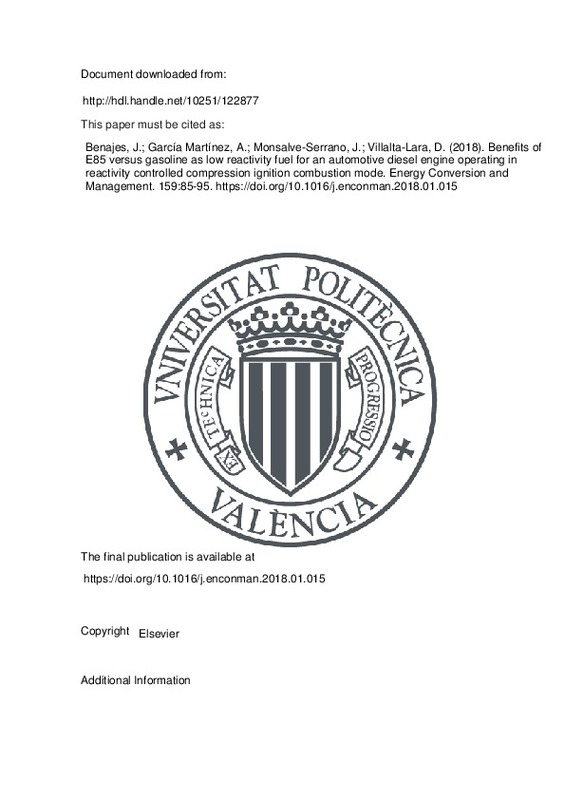JavaScript is disabled for your browser. Some features of this site may not work without it.
Buscar en RiuNet
Listar
Mi cuenta
Estadísticas
Ayuda RiuNet
Admin. UPV
Benefits of E85 versus gasoline as low reactivity fuel for an automotive diesel engine operating in reactivity controlled compression ignition combustion mode
Mostrar el registro sencillo del ítem
Ficheros en el ítem
| dc.contributor.author | Benajes, Jesús
|
es_ES |
| dc.contributor.author | García Martínez, Antonio
|
es_ES |
| dc.contributor.author | Monsalve-Serrano, Javier
|
es_ES |
| dc.contributor.author | Villalta-Lara, David
|
es_ES |
| dc.date.accessioned | 2019-06-28T20:04:21Z | |
| dc.date.available | 2019-06-28T20:04:21Z | |
| dc.date.issued | 2018 | es_ES |
| dc.identifier.issn | 0196-8904 | es_ES |
| dc.identifier.uri | http://hdl.handle.net/10251/122877 | |
| dc.description.abstract | [EN] This work shows the capabilities of E85 fuel to be used as low reactivity fuel in a high compression ratio light-duty diesel engine (17.1:1) running under reactivity controlled compression ignition concept. To do this, experimental steady-state engine maps are obtained in a single-cylinder engine with diesel-E85 fuel combination. The engine mapping was performed following the same procedure used in previous works with other fuel combinations to allow the results comparison. Considering the mechanical and emissions limits imposed during the engine mapping, it was found that with diesel-E85 the combustion concept is limited to the region defined from 2 to 7 bar at 1000 rpm, and from 1.5 to 9 bar indicated mean effective pressure at 3000 rpm. This operating region was satisfied with nitrogen oxides, soot and pressure rise rate levels below 0.4 g/kWh, 0.01 g/kWh and 10 bar/CAD, respectively. The reactivity controlled compression ignition maps with diesel-E85 were obtained taking as reference the total fuel energy used in a previous work to map the engine with diesel-gasoline. The direct comparison of both combustion concepts (diesel-E85 and diesel-gasoline) revealed that E85 allows to extend the engine map around 2 bar indicated mean effective pressure towards the high load region. Moreover, the minimum load achieved at high engine speeds was decreased down to 1.5 indicated mean effective pressure. Finally, the differences in terms of emissions and performance between both reactivity controlled compression ignition concepts are highlighted by doing the difference between the maps of several variables. | es_ES |
| dc.description.sponsorship | The authors gratefully acknowledge General Motors Global Research & Development for providing the engine used in this investigation. The authors also acknowledge FEDER and Spanish Ministerio de Economia y Competitividad for partially supporting this research through HiReCo project (TRA2014-58870-R). | es_ES |
| dc.language | Inglés | es_ES |
| dc.publisher | Elsevier | es_ES |
| dc.relation.ispartof | Energy Conversion and Management | es_ES |
| dc.rights | Reconocimiento - No comercial - Sin obra derivada (by-nc-nd) | es_ES |
| dc.subject | Reactivity controlled compression ignition | es_ES |
| dc.subject | Dual-fuel combustion | es_ES |
| dc.subject | Engine map | es_ES |
| dc.subject | Efficiency | es_ES |
| dc.subject | Ethanol | es_ES |
| dc.subject.classification | MAQUINAS Y MOTORES TERMICOS | es_ES |
| dc.title | Benefits of E85 versus gasoline as low reactivity fuel for an automotive diesel engine operating in reactivity controlled compression ignition combustion mode | es_ES |
| dc.type | Artículo | es_ES |
| dc.identifier.doi | 10.1016/j.enconman.2018.01.015 | es_ES |
| dc.relation.projectID | info:eu-repo/grantAgreement/MINECO//TRA2014-58870-R/ES/REDUCCION DE LAS EMISIONES DE CO2 EN VEHICULOS PARA TRANSPORTE USANDO COMBUSTION DUAL NATURAL GAS-DIESEL/ | es_ES |
| dc.rights.accessRights | Abierto | es_ES |
| dc.contributor.affiliation | Universitat Politècnica de València. Departamento de Máquinas y Motores Térmicos - Departament de Màquines i Motors Tèrmics | es_ES |
| dc.description.bibliographicCitation | Benajes, J.; García Martínez, A.; Monsalve-Serrano, J.; Villalta-Lara, D. (2018). Benefits of E85 versus gasoline as low reactivity fuel for an automotive diesel engine operating in reactivity controlled compression ignition combustion mode. Energy Conversion and Management. 159:85-95. https://doi.org/10.1016/j.enconman.2018.01.015 | es_ES |
| dc.description.accrualMethod | S | es_ES |
| dc.relation.publisherversion | https://doi.org/10.1016/j.enconman.2018.01.015 | es_ES |
| dc.description.upvformatpinicio | 85 | es_ES |
| dc.description.upvformatpfin | 95 | es_ES |
| dc.type.version | info:eu-repo/semantics/publishedVersion | es_ES |
| dc.description.volume | 159 | es_ES |
| dc.relation.pasarela | S\350911 | es_ES |
| dc.contributor.funder | Ministerio de Economía, Industria y Competitividad | es_ES |







![[Cerrado]](/themes/UPV/images/candado.png)

